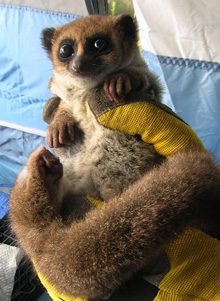Biodiversity of Tsinjoarivo
Biological surveys in the Tsinjoarivo region, though brief, have indicated a high level of biodiversity, with at least: 11 primates, 17 tenrecs (the highest tenrec diversity in Madagascar), 7 rodents (including 5 endemic nesomyines), 6 carnivores (including 4 endemic Eupleridae), 92 birds, 27 reptiles and 44 amphibians. In particular, this region is now recognized as having the highest species diversity of Tenrecidae (insectivores in the order Afrosoricida) in Madagascar. Ongoing botanical surveys have so far indicated the presence of at least 247 plant species. The potential for high diversity and endemism in the Tsinjoarivo area is due to three biogeographic factors. First, two major rivers barriers separate the Tsinjoarivo forest from the rest of the corridor: the Onive river to the south, and the Mangoro river to the east. Second, Tsinjoarivo represents a biogeographic transition between the eastern rainforests and Madagascar's largely-deforested central plateau. Third, Tsinjoarivo is a high-altitude “island” – though the forest is continuous to the south and northeast, altitude drops sharply in both directions. Thus, it is likely that further biological survey work will reveal more new animal and plant species.
- Click here for a list of mammal and bird species recorded at Tsinjoarivo. [pdf format - 70kb]
- Click here for a list of plant species recorded at Tsinjoarivo. [pdf format - 75kb]
- NOTE: Reptile and Amphibian species coming soon!
 Parson's Chameleon, Calumma parsoni |
|
More about the lemurs of Tsinjoarivo (listed by their three names: Scientific, English and Malagasy):
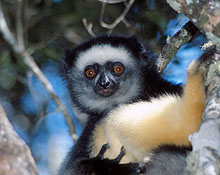 |
Propithecus diadema Diademed Sifaka / “Sadabe”: This species is the largest and most distinctive lemur at Tsinjoarivo. They feed on leaves, fruits, flowers and seeds, and are active during the day. Sadabe live in continuous forest and survive in large to medium-sized forest fragments, but their body mass is reduced in fragments and these populations show signs of stress. For more information on this species, click here. |
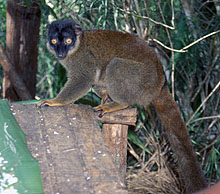 |
Eulemur fulvus This diurnal lemur is mainly frugivorous and lives in fairly large and noisy groups of around 10-15 animals. Though they are common in the intact forest at Vatateza, Varika have been lost in all but the largest forest fragments around Tsinjoarivo – this is probably due to a combination of the loss of their preferred fruit trees and the hunting that occurred in the recent past. |
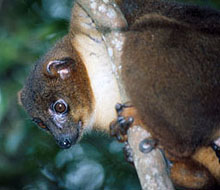 |
Eulemur rubriventer Red-bellied Lemur / “Varika mena”: This diurnal lemur, related to the Varika, is a distinct red-brown colour. The females have a white chest and the males have white teardrop-shaped patches at the inside corner of their eyes. They are mainly frugivorous, like the Varika, but live in smaller groups consisting of just one male, one female and 1-2 offspring. Like the Varika, they have been lost from all but the largest forest fragments. |
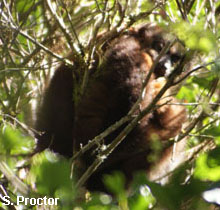 |
Prolemur simus Greater Bamboo Lemur / “Kotraika”: This lemur was only recently discovered at Tsinjoarivo, following the discovery of its distinctive feeding traces in 2008. Little is known of its ecology at Tsinjoarivo, but at other sites it specializes on the larger forest bamboo species. It is patchily distributed, and probably quite rare within Tsinjoarivo forest. |
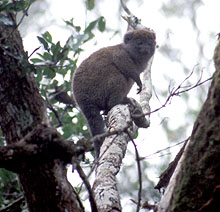 |
Hapalemur griseus griseus Gray Bamboo Lemur / “Kotraika”: This lemur feeds extensively on the leaves, shoots and stems of bamboo but is also known to eat fruits and leaves of other plants, including mistletoe. They are diurnal and live in medium-sized groups of 2-5 animals. They can be found in continuous forest and in many forest fragments, perhaps because of the prolific growth of bamboo there. |
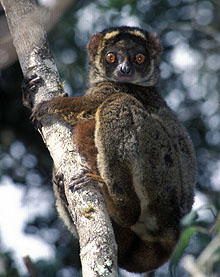 |
Avahi laniger Eastern Woolly Lemur / “Ramiona”: This nocturnal lemur is related to the larger, diurnal sadabe. It is mainly folivorous and has a small home range. This species lives in monogamous pairs, but individuals often travel alone. It can be found in both continuous forest and some forest fragments at Tsinjoarivo. |
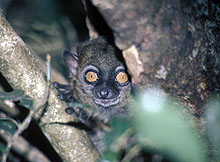 |
Lepilemur mustelinus Weasel Sportive Lemur / “Tsidika”: This nocturnal lemur is also folivorous and sleeps in tree holes. They are usually encountered as solitary animals, and can be found in continuous forest and some forest fragments (even quite small ones) at Tsinjoarivo. |
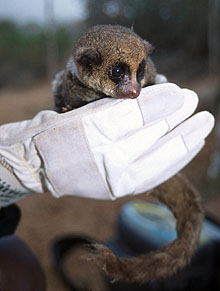 |
Cheirogaleus sibreei Sibree's Dwarf Lemur / “Matavirambo”: This small nocturnal lemur was first described in 1896, but throughout the 20th century this species was only known from museum specimens. It was thus unclear whether it was truly a distinct species in the wild, and if so, whether it still existed. Genetic and morphological research led by Marina Blanco, Vololona Rahalinarivo and Linn Groeneveld demonstrated that a small remnant population persisted at Tsinjoarivo. Currently, Tsinjoarivo is this species’ only confirmed locality, and it is likely the rarest of all Cheirogaleus species. This dwarf lemur hibernates from May to October to get through the season of low resource abundance. Before starting to hibernate in May, they grow relatively fat, especially the tail (the name Matavirambo means “fat tail”). Their diet consists mainly of fruit, flower nectar, young leaves and buds. . |
|
|
Cheirogaleus crossleyi Crossley's Dwarf Lemur / “Matavirambo”: The second dwarf lemur species at Tsinjoarivo is more widespread, though patchily distributed, in Madagascar's eastern rainforests. This small nocturnal lemur also hibernates from April to September to get through the season of low resource abundance. Before starting to hibernate in May, they grow relatively fat, especially the tail (the name Matavirambo means “fat tail”). Their diet consists mainly of fruit, flower nectar, young leaves and buds. This species' hibernation patterns and ecology are being studied by Marina Blanco and Vololona Rahalinarivo.. |
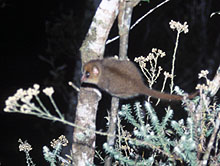 |
Microcebus lehilahytsara |
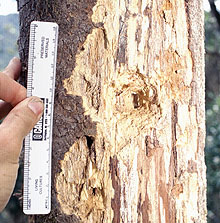 |
Daubentonia madagascariensis Aye-aye / "Hay-hay": This nocturnal animal is widely regarded as the most bizarre of lemurs. Their strange morphological specializations include large bat-like ears (for hearing insect larvae within dead trees), thick ever-growing incisors (for gnawing into food sources, including dead trees), and thin, long middle fingers (for extracting food from tight spaces). Aye-ayes have never been sighted by our research teams at Tsinjoarivo, but we have seen distinct feeding traces (larva extraction in dead trees and feeding on the seeds of the Ramy tree, Canarium madagascariense). |


